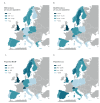Increase of invasive meningococcal serogroup W disease in Europe, 2013 to 2017
- PMID: 30968827
- PMCID: PMC6462787
- DOI: 10.2807/1560-7917.ES.2019.24.14.1800245
Increase of invasive meningococcal serogroup W disease in Europe, 2013 to 2017
Abstract
BackgroundThe total incidence of invasive meningococcal disease (IMD) in Europe has been declining in recent years; however, a rising incidence due to serogroup W (MenW), predominantly sequence type 11 (ST-11), clonal complex 11 (cc11), was reported in some European countries.AimThe aim of this study was to compile the most recent laboratory surveillance data on MenW IMD from several European countries to assess recent trends in Europe.MethodsIn this observational, retrospective study, IMD surveillance data collected from 2013-17 by national reference laboratories and surveillance units from 13 European countries were analysed using descriptive statistics.ResultsThe overall incidence of IMD has been stable during the study period. Incidence of MenW IMD per 100,000 population (2013: 0.03; 2014: 0.05; 2015: 0.08; 2016: 0.11; 2017: 0.11) and the proportion of this serogroup among all invasive cases (2013: 5% (116/2,216); 2014: 9% (161/1,761); 2015: 13% (271/2,074); 2016: 17% (388/2,222); 2017: 19% (393/2,112)) continuously increased. The most affected countries were England, the Netherlands, Switzerland and Sweden. MenW was more frequent in older age groups (≥ 45 years), while the proportion in children (< 15 years) was lower than in other age groups. Of the culture-confirmed MenW IMD cases, 80% (615/767) were caused by hypervirulent cc11.ConclusionDuring the years 2013-17, an increase in MenW IMD, mainly caused by MenW cc11, was observed in the majority of European countries. Given the unpredictable nature of meningococcal spread and the epidemiological potential of cc11, European countries may consider preventive strategies adapted to their contexts.
Keywords: Europe; Neisseria menigitidis; airborne infections; bacterial infections; epidemiology; meningococcal disease; serogroup W; surveillance.
Conflict of interest statement
Anna Skoczyńska: Assistance to attend scientific meetings and honoraria for lecturing funded from Baxter, GSK, Novartis and Pfizer; attendance in the Advisory Boards of GSK, Pfizer and Sanofi Pasteur; grants on behalf of the National Medicines Institute, Poland, from GSK, Novartis and Pfizer.
Paola Stefanelli declares research projects by Pfizer and GSK payed to the institution.
Arie van der Ende reports an Investigator Initiated Research Project (Study ID# WI173197) by Pfizer payed to the Institution and consultancy activities for GSK and Pfizer payed to the Institution.
Maija Toropainen reports grants from GlaxoSmithKline and Pfizer to the National Institute for Health and Welfare for research projects in which she is a co-investigator.
Julio Vazquez acts as temporal advisor and receives grants for research from Sanofi-Pasteur, Novartis Vaccines, GlaxoSmithKline and Pfizer.
Ray Borrow performs contract research on behalf of Public Health England for GSK, Pfizer and Sanofi Pasteur.
Figures





References
-
- Knol MJ, Hahné SJM, Lucidarme J, Campbell H, de Melker HE, Gray SJ, et al. Temporal associations between national outbreaks of meningococcal serogroup W and C disease in the Netherlands and England: an observational cohort study. Lancet Public Health. 2017;2(10):e473-82. 10.1016/S2468-2667(17)30157-3 - DOI - PubMed
-
- Campbell H, Parikh SR, Borrow R, Kaczmarski E, Ramsay ME, Ladhani SN. Presentation with gastrointestinal symptoms and high case fatality associated with group W meningococcal disease (MenW) in teenagers, England, July 2015 to January 2016. Euro Surveill. 2016;21(12):30175. 10.2807/1560-7917.ES.2016.21.12.30175 - DOI - PubMed
Publication types
MeSH terms
Grants and funding
LinkOut - more resources
Full Text Sources
Medical
